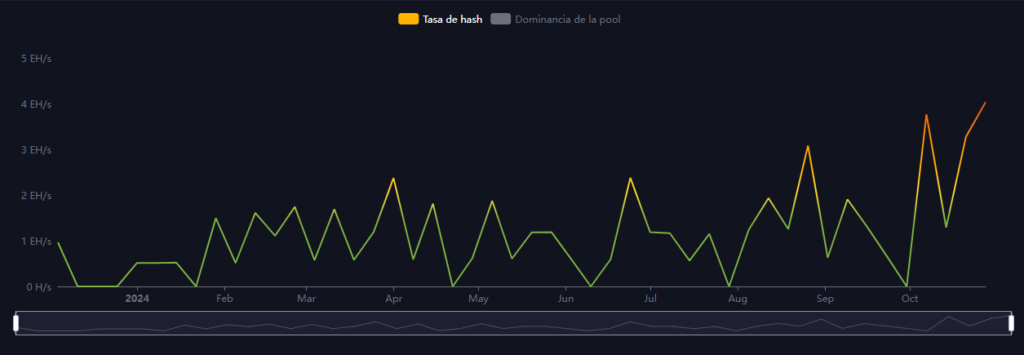-
Prior to the DATUM protocol, this pool had an average of 1 block mined per month since June.
-
Users entering this pool in October caused an increase in the hash rate.
Since October 2024 began, the Bitcoin (BTC) Mining pool Ocean, through its new decentralized mining protocol DATUM (“Decentralized Alternative Templates for Universal Mining”), managed to mine 13 blocks of the total of the 20 it found in this month.
How explained CriptoNoticias recently, the implementation of this new technology to work on the Bitcoin network had raised positive signs since the beginning of October.
The Ocean pool allows individual mining through DATUM. This tool aims at better decentralization in the bitcoin mining. Of course, getting the total rewards for processing a block with an individual user’s hashrate is also extremely difficult and strange to happeneven if it is done via a pool.
Using as a reference the months from June to September inclusive, a period in which Ocean did not offer its DATUM protocol, the average block found by Ocean was 1 block per month.
Therefore, considering that in October 13 blocks were found with DATUM, in percentage terms, the new protocol would have increased this Ocean’s individual mining capacity by 1,200% in October compared to the previous 4 months.
DATUM may have attracted new users to Ocean
This performance improvement could also be explained due to the increase in the Ocean pool hash rate since October. Perhaps a larger number of users were enticed to try and interact with the new decentralized mining technology, which led to more users contributing their hash rate to the pool.
When September began, according to mempool, Ocean’s hashrate was close to 0 EH/s (exahashes per second). Although it dropped in the second week of October, this metric is currently at 4.6 EH/s (exahashes per second), which represents a record figure, at least in 2024, according to the data.


Ocean’s hashrate is at its highest point in 2024. Source: mempool.
Today, October 30, 2024, Ocean managed to mine a new block using DATUM. Mempool data reveals that block 868078 was found by user Ocean “Electronic Energy”.
This will tipped an individual miner reward of 0.031 BTC ($2,220 at the time of this article) for user transaction fees. Added to this, the fixed block subsidy reward of 3,125 BTC (after the halving of bitcoin April 2024) plus expenses for a total of 3,156 BTC, equivalent to 228,923 dollars.


Ocean’s new DATUM protocol allows you to see the name of the miner who found that block. Fountain: mempool.
In the previous photo, in the section dedicated to the name of the miner (in this case “Electronic Energy”), it is clarified that this block was successfully processed by that particular Ocean pool user. Individual mining of this pool is done using DATUM.
If, on the other hand, only the name “Ocean” is seen in that box, then this means that the block was processed by the pool.
Thus, DATUM enables users to contribute with their own resources, participating in the network without having to be part of a traditional pool that redistributes rewards and using Ocean’s infrastructure.
In conclusion, the performance of the DATUM protocol during October shows great potential to revolutionize individual mining on Ocean, providing a significant increase in performance for independent miners.
However, although these results are promising, it is important to remember that this is just one month of operation. To fully assess the impact and viability of DATUM, it will be essential to monitor its performance in the coming months, analyzing both its consistency and its ability to adapt to changing market conditions.
Crypto Keynote USA
For the Latest Crypto News, Follow ©KeynoteUSA on Twitter Or Google News.






